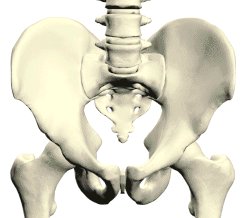Sections

Figure 18
|
Sections |
 Figure 18 |
The pelvis consists of a series of plate like bones , as shown in Figure 18 forming a ring or girdle to support the torso on top of the legs forming a link between the lumbar spine and the upper part of the thigh or femur. The area inside the pelvic girdle forms the lower part of the abdominal cavity containing the lower intestines, bladder and female reproductive organs. The pelvis is symmetrical and consists of a series of fused bones:
The sacrum and illium are large and structurally stronger than the other two as these take the vertical and longitudinal loads from the pelvis to the lumbar spine. The pubis bone are the weakest maintaining the pelvic girdle at the front.
In the rail environment, the seated occupants pelvis is rarely exposed to direct impact. In frontal impacts it would be from indirect loading via axial loads in the femur resulting from knee and lower leg impacts with lower seat backs or bases. These produce high shear forces at the hip joint. In lateral seating the impact surface, either partition walls, panels or seat backs, impact the greater trochanter on the upper femur, which transfers load directly into the pelvis, via the hip joint.
Standing occupants however may impact the pelvis directly, impacting exposed blunt objects such as lower seat backs or grab poles, producing isolated fractures at the point of impact, a complex series of fractures due to indirect loads, as seen in automotive pedestrian impacts.
Injuries to the pelvis are not life threatening, but due to the complex load bearing nature of the pelvis and difficulties in realigning the bones, complex comminuted fractures can produce long-term disabilities.